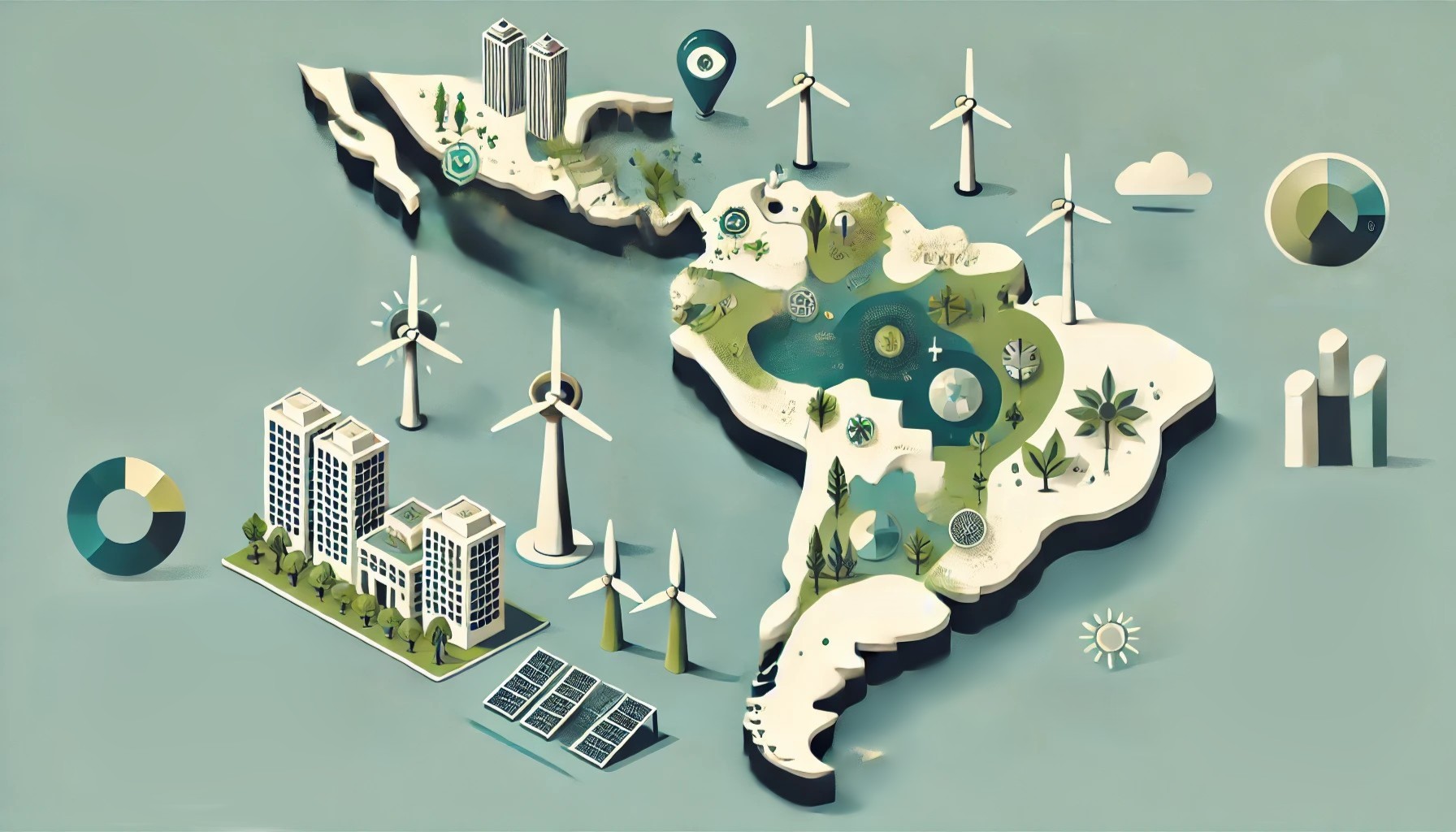Sustainable Finance was once considered a niche, a concept spoken softly in the corridors of banks and investment firms. Today, it has become a powerful movement transforming financial markets worldwide—and Latin America is at its forefront. Across this vibrant region, from Mexico’s bustling cities to Brazil’s Amazon forests and Chile’s mountainous landscapes, the rise of Sustainable Finance tells a compelling story of ambition, innovation, and perseverance.
This story explores how Sustainable Finance—a method of integrating environmental and social goals into investments—took root in Latin America, how it has flourished, and the barriers it has faced. You’ll discover how pioneering efforts by national governments, innovative companies, and influential development banks reshaped the financial landscape, and why the future of Sustainable Finance holds extraordinary promise for the region.
Planting the Seed: The Emergence of Sustainable Finance in Latin America
The journey of Sustainable Finance in Latin America began in earnest around 2015. At the time, green bonds were still relatively unknown, often viewed skeptically by traditional investors. Yet Latin America—facing growing challenges from climate change, environmental degradation, and social inequalities—proved a fertile ground for these innovative instruments.
In 2015, Brazil and Mexico broke new ground, each launching landmark green bond transactions. Brazil’s BRF, a leading agricultural company, was among the first to venture into these waters, raising millions of dollars to finance sustainable operations. Mexico soon followed suit, with Nacional Financiera (NAFIN), a major state-owned development bank, successfully launching its inaugural green bond to fund renewable energy projects. This early success wasn’t just financial; it symbolized a significant cultural shift. Latin America was signaling to global markets that sustainability was more than idealism—it was becoming central to strategic finance.
Within months, others joined the movement. Local governments, businesses, and banks across the continent began experimenting with thematic bonds. Mexico City issued Latin America’s first municipal green bond in 2016, pioneering sustainable urban infrastructure finance. Chile’s first green bond arrived shortly thereafter in 2017, issued by forestry giant Inversiones CMPC to promote sustainable forestry practices.
But despite these pioneering efforts, sustainable bonds initially represented only a small fraction of the region’s total debt issuance. Skeptics questioned their scalability and genuine impact. However, change was underway. A powerful turning point was about to reshape the landscape—the rise of sovereign sustainable bonds.
National Champions: Mexico, Brazil, and Chile Leading the Way
Mexico: Setting New Standards
Mexico emerged early as a vibrant leader in Latin America’s Sustainable Finance movement. The stage was set in late 2015, when Nacional Financiera (NAFIN), a major state-owned development bank, launched Mexico’s first-ever green bond. This pioneering USD 500 million issuance, aimed at funding wind energy projects, was met with overwhelming demand. It marked a critical milestone: Mexico had publicly embraced sustainability within its financial strategy, signaling a new chapter in Latin American finance.
Building on this momentum, Mexico City issued Latin America’s first municipal green bond in 2016. The city’s ambitious financing aimed at sustainable urban infrastructure highlighted the potential for local governments across the region to actively participate in the green revolution. Soon after, Mexico became home to another landmark—major corporations, from Coca-Cola FEMSA to real estate giant Fibra Prologis, embraced green bonds, channeling millions into renewable energy and sustainable buildings.
But Mexico’s most dramatic move came in 2020, when it stunned global markets by issuing the world’s first sovereign bond explicitly tied to the UN’s Sustainable Development Goals (SDGs). This groundbreaking transaction raised nearly EUR 750 million, directing funds toward social and environmental programs tied directly to global development objectives. The bond was oversubscribed several times, vividly demonstrating that investors worldwide were hungry for credible and impactful sustainability investments. This bold, innovative step placed Mexico at the forefront of the global Sustainable Finance stage.
Mexico’s progress was matched by strong governmental action, including the establishment of the country’s first Sustainable Finance taxonomy in 2023. By clearly defining what constituted eligible green and social investments, Mexico paved the way for greater transparency, credibility, and confidence in the market—sending a powerful signal to international investors that the country was serious about sustainable development.
Brazil: Corporate Giants and Sovereign Awakening
While Mexico’s early success was driven largely by public institutions, Brazil’s Sustainable Finance narrative unfolded differently, led initially by its private sector. Corporate giants took bold strides forward, issuing pioneering sustainability-linked bonds that captured global attention. In 2020, Suzano, Brazil’s massive pulp and paper company, issued the first-ever sustainability-linked bond in the Americas, directly linking its borrowing costs to ambitious environmental goals, such as significantly reducing carbon emissions and improving water management.
Following Suzano’s lead, other industry titans—including Klabin, JBS, and Natura—launched their own thematic bonds, promising to meet specific sustainability targets. These transactions sent ripples across global markets, positioning Brazilian corporations as leaders willing to tie their financial performance to concrete environmental and social outcomes.
However, Brazil’s sovereign journey began cautiously. It wasn’t until 2023 that Brazil finally entered the sovereign Sustainable Finance market, issuing its inaugural USD 2 billion sustainability bond. The deal was met with immense investor demand and enthusiasm, signaling long-awaited government commitment to sustainability and generating momentum for the nation’s Sustainable Finance journey. Just months later, Brazil issued another successful sovereign bond, further establishing its presence on the global stage and solidifying its commitment.
This newfound sovereign engagement coincided with increasingly active regulatory involvement. Brazil’s central bank stepped into the spotlight, introducing a comprehensive sustainability agenda that compelled banks and financial institutions to integrate environmental risks into their lending decisions and stress tests. Simultaneously, the Brazilian government began developing its own Sustainable Finance taxonomy, promising to create greater clarity and credibility around sustainable investing.
With a combination of robust corporate action, newfound sovereign commitment, and decisive regulatory reform, Brazil had transformed from cautious observer to influential leader—demonstrating how sustainability could become a core component of national economic policy.
Chile: Setting Global Standards
Among the region’s pioneers, Chile stands out as the most ambitious sovereign actor in Sustainable Finance—setting standards not only for Latin America but for the world. In 2019, Chile became the first country in the Americas to issue a sovereign green bond, raising over USD 1.4 billion in a landmark issuance. Funds raised were dedicated to clean transportation, renewable energy projects, and sustainable water management—each aligned with Chile’s aggressive climate objectives.
The groundbreaking issuance was met with an overwhelming response from global markets, achieving record-low yields and demonstrating a powerful appetite for Latin American ESG debt. But Chile was just getting started. The government quickly followed this success by issuing additional green bonds, rapidly expanding its sustainable debt portfolio to billions of dollars within just two years.
In 2021, Chile broadened its scope, issuing sovereign social and sustainability bonds to finance pandemic response and critical social programs, setting a further example for other emerging markets. But perhaps Chile’s boldest move occurred in 2022, when it launched the world’s first-ever sovereign sustainability-linked bond, tying its borrowing costs directly to its commitments on greenhouse gas reductions and renewable energy expansion. Global investors applauded this innovative approach, pouring capital into the deal and positioning Chile as a true global ESG finance champion.
Chile didn’t rest on its laurels, though. By 2023, it had added additional ambitious KPIs, such as gender equality metrics, to its sovereign sustainability-linked framework. Chile’s sustained innovation inspired other countries and significantly influenced the trajectory of Sustainable Finance across Latin America and beyond.
Behind this dramatic success was a deliberate, coordinated strategy from Chile’s government and regulators. Clear, ambitious sustainability targets, robust ESG disclosure rules, and dedicated green bond frameworks provided the solid foundation necessary to attract global capital. The Chilean Green Finance Roundtable fostered close collaboration among regulators, banks, and investors, creating an ecosystem conducive to rapid growth.
Through decisive action, bold innovation, and strategic policy, Chile positioned itself at the global forefront of Sustainable Finance—proving that with visionary leadership, ambitious sustainability goals were not just possible, but highly profitable.
Collectively, the stories of Mexico, Brazil, and Chile illustrate how Latin America transformed Sustainable Finance from a niche concept into a powerful force reshaping global markets. Their distinct paths—Mexico’s innovative public-sector financing, Brazil’s corporate leadership followed by sovereign awakening, and Chile’s remarkable sovereign boldness—highlight a region rich with diversity and united by ambition. Together, these three nations have planted seeds that promise a future of sustained growth and meaningful social and environmental progress throughout Latin America.
Catalysts of Change: The Crucial Role of Development Banks
Behind Latin America’s Sustainable Finance movement stood a set of powerful catalysts—multilateral and national development banks that quietly but decisively reshaped the region’s financial landscape. These institutions provided more than just funding; they were architects, innovators, and risk-takers, laying foundations critical for the region’s sustainability revolution.
At the heart of this transformation stood the Inter-American Development Bank (IDB), one of the earliest and most active champions of Sustainable Finance in Latin America. From the outset, IDB recognized that the region urgently needed to mobilize private investment toward environmental and social objectives. It began offering partial credit guarantees, concessional loans, and critical anchor investments that made pioneering bond issuances possible—encouraging hesitant private investors by sharing risk and demonstrating viability.
The IDB not only financed groundbreaking projects but also actively fostered market infrastructure. It launched influential platforms such as the Green Bond Transparency Platform, enhancing trust by standardizing reporting for green bonds across Latin America. Through the Green Finance LAC initiative, IDB provided vital technical assistance, sharing best practices and nurturing a community of public and private stakeholders committed to sustainability.
Perhaps the IDB’s most symbolic role was its support for landmark sovereign issuances. When Ecuador launched its first-ever sovereign social bond in 2020—targeting affordable housing—the IDB provided crucial backing, helping secure investor confidence. This pattern repeated elsewhere, as IDB expertise facilitated sovereign sustainable bond frameworks in countries such as Colombia and Chile. By blending financial muscle with technical guidance, the IDB became both catalyst and mentor—fueling market momentum and ensuring Latin America’s Sustainable Finance structures could stand tall on the global stage.
Alongside the IDB stood another regional giant, the CAF – Development Bank of Latin America, previously known as the Andean Development Corporation. CAF recognized early on that to accelerate sustainability across the region, it needed to act as both lender and borrower, setting an example for local markets. In 2019, CAF boldly stepped onto the international stage, issuing its first public green bond—raising €750 million dedicated to sustainable infrastructure across Latin America. The success of this issuance was followed by further sustainable and social bonds in multiple currencies, showcasing CAF’s ability to mobilize substantial capital from international markets.
Beyond issuing its own bonds, CAF became a hands-on partner to governments and businesses throughout Latin America, providing project preparation support and training local banks on green finance practices. It was also instrumental in regional taxonomy discussions, helping harmonize definitions of sustainable activities to make investments clearer and more credible. CAF’s dual role—both as a respected issuer in global markets and a trusted local lender—significantly expanded the scope and credibility of Sustainable Finance across the region.
Meanwhile, the World Bank Group, including both the International Bank for Reconstruction and Development (IBRD) and the International Finance Corporation (IFC), played a transformative role behind the scenes. Known globally for pioneering the first-ever green bonds, the World Bank brought its deep expertise to Latin America, advising countries as they prepared their inaugural thematic bond issuances. It helped Colombia navigate its landmark local currency sovereign green bond, turning a groundbreaking concept into reality and laying a foundation for future domestic issuances across the region.
Finally, within Brazil, the story of Sustainable Finance could not be told without the transformative influence of Brazil’s National Development Bank (BNDES). Traditionally viewed as a major financier of heavy infrastructure and industry, BNDES began a strategic shift toward sustainability in the late 2010s, dramatically altering Brazil’s financial landscape. Its milestone USD 1 billion green bond issuance in 2017, the first international green bond issued by any Brazilian bank, was a watershed moment. The bond financed wind and solar energy projects, demonstrating to Brazil’s financial community that sustainable investments were not only feasible but highly attractive.
BNDES didn’t stop there. In 2020, it innovated locally with green financial notes tailored specifically for Brazilian investors, significantly expanding access to sustainable instruments. In 2021, the bank unveiled a comprehensive Sustainability Bond Framework covering green, social, and sustainable bonds, further signaling its long-term commitment. BNDES also undertook an ambitious program of domestic sustainability finance, actively funding reforestation projects, sustainable sanitation initiatives, and low-carbon infrastructure. This national development bank became Brazil’s sustainability champion, setting market standards, building expertise, and reshaping perceptions—showing local financial institutions the power and profitability of Sustainable Finance.
Collectively, these development banks—the IDB, CAF, the World Bank Group, and BNDES—proved to be indispensable architects of Latin America’s Sustainable Finance revolution. They acted decisively to de-risk innovative instruments, foster crucial market infrastructure, and mobilize vast pools of global capital. They invested deeply in regional capacity-building, cultivated trust, and systematically dismantled barriers to market growth. As a result, Latin America’s Sustainable Finance market grew not just in scale but in sophistication, moving from hesitant beginnings into mainstream financial practice.
In doing so, these influential institutions demonstrated that financial markets could indeed become powerful engines for meaningful environmental and social change—ensuring a sustainable legacy for future generations across Latin America.
Obstacles on the Path: Barriers to Sustainable Finance Growth
Despite these remarkable advances, Latin America’s journey has not been without challenges. Regulatory inconsistencies, unclear standards, and inadequate institutional support slowed market growth. Many countries lacked taxonomies, leaving room for greenwashing. Political and economic volatility, high borrowing costs, currency risks, and limited investor awareness created additional hurdles, deterring some international investors.
Structurally, Latin America faced difficulties developing projects of adequate scale to attract thematic bond financing. Climate adaptation and social impact initiatives often proved complex, smaller, and harder to finance than large renewable energy infrastructure. Overcoming these barriers required patience, policy reforms, regulatory clarity, and innovative financing structures designed specifically to handle these challenges.
Toward a Brighter Horizon: Latin America’s Future in Sustainable Finance
Despite these challenges, the future looks remarkably promising. Latin America is poised to significantly scale its Sustainable Finance market, driven by innovative new instruments like sustainability-linked loans, blue bonds, gender-focused bonds, and transition finance. Countries are increasingly adopting national taxonomies aligned with international standards, providing investors with much-needed transparency.
Moreover, as sovereign bonds become more prevalent, they’ll establish reliable benchmarks, guiding private sector issuances and catalyzing domestic market growth. Multilateral initiatives and international climate finance flows offer additional momentum, providing crucial concessional capital and risk-sharing mechanisms to support sustainable development goals.
As sustainability principles become increasingly embedded into mainstream finance and investment practices, Latin America’s financial institutions, pension funds, and companies will find new opportunities to mobilize vast pools of capital toward sustainable projects.
Conclusion: A Region Ready to Flourish
The rise of Sustainable Finance in Latin America represents not just a financial shift, but a profound cultural and strategic transformation. What began with pioneering transactions by visionary governments and daring corporations has now evolved into a dynamic, mature market with global influence.
Mexico’s innovation, Brazil’s corporate leadership, and Chile’s sovereign boldness have laid strong foundations for a region-wide movement. Despite barriers, Sustainable Finance in Latin America continues to grow, driven by necessity, ambition, and innovation.
This vibrant region stands ready to transform its financial markets, paving the way for environmental and social progress on a scale never before seen. Latin America’s journey proves that with commitment and vision, finance can truly become a powerful engine for positive global change.


